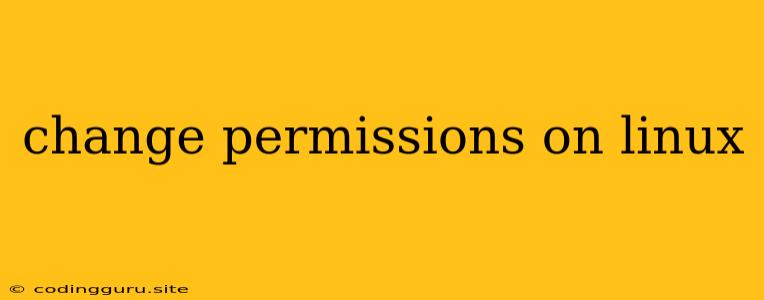Understanding and Changing Permissions on Linux
Linux is a powerful operating system that thrives on its flexibility and granular control over system resources. One key aspect of this control is permissions, which dictate who can access and modify files and directories. Understanding and manipulating permissions is crucial for maintaining the security and stability of your Linux system.
Why are Linux Permissions Important?
Imagine a bustling city where everyone has free access to every building and street. Chaos and disorder would ensue! Similarly, without proper permissions, your Linux system would be vulnerable to unauthorized access, modification, and even deletion of critical files.
Permissions act as a gatekeeper, ensuring that:
- Only authorized users can access and modify files. This prevents accidental or malicious changes from corrupting data.
- System files remain protected from accidental user modifications. Crucial system components need to be kept untouched for proper operation.
- Sensitive data, such as passwords or financial information, is safe from prying eyes. This is essential for privacy and data security.
Understanding Permission Basics
Linux permissions are represented using a three-digit system, where each digit denotes a specific type of access:
- Read (r): Allows users to view the contents of a file or directory.
- Write (w): Allows users to modify the contents of a file or directory.
- Execute (x): Allows users to run programs or scripts stored within a directory.
Permissions for Users, Groups, and Others
Each file or directory in Linux has three sets of permissions:
- User: The owner of the file or directory.
- Group: A group of users who share access to the file or directory.
- Others: Anyone else who is not the owner or a member of the group.
For example:
drwxrwxr-x 2 user group 4096 Nov 16 10:11 directory
- d: This indicates the file is a directory.
- rwx: The owner (user) has read, write, and execute permissions.
- rwx: The group has read, write, and execute permissions.
- r-x: "Others" have read and execute permissions, but not write permissions.
How to Change Permissions
The chmod command is your trusty tool for modifying permissions. It comes in two flavors:
1. Symbolic Mode:
-
chmod [operation][permissions] [file/directory]- Operation:
+to add permissions,-to remove,=to set specific permissions. - Permissions:
u(user),g(group),o(others),a(all), followed byr(read),w(write),x(execute).
- Operation:
Example:
chmod u+w file.txtAdds write permissions for the owner offile.txt.chmod go-x directory/Removes execute permissions for the group and others from thedirectory.chmod a=rwx file.jpgSets read, write, and execute permissions for everyone onfile.jpg.
2. Numeric Mode:
-
chmod [mode] [file/directory]- Mode: A three-digit number representing permissions for user, group, and others. Each digit ranges from 0 to 7:
- 0: No permissions
- 1: Execute only
- 2: Write only
- 3: Write and execute
- 4: Read only
- 5: Read and execute
- 6: Read and write
- 7: Read, write, and execute
- Mode: A three-digit number representing permissions for user, group, and others. Each digit ranges from 0 to 7:
Example:
chmod 755 file.shSets permissions forfile.shas follows:- User: Read, write, and execute (7)
- Group: Read and execute (5)
- Others: Read and execute (5)
Common Use Cases for Changing Permissions
-
Making a directory writable by everyone:
chmod a+w /path/to/directory -
Making a script executable:
chmod +x script.sh -
Restricting access to a sensitive file:
chmod go-rw sensitive.txt
Important Considerations
- Use
sudofor changing permissions on system files. You need root privileges for this. - Be cautious! Incorrect permissions can render your system unusable.
- Use specific permissions whenever possible. Avoid giving blanket permissions like
a=rwxunless absolutely necessary.
Conclusion
Understanding and managing Linux permissions is crucial for system security, stability, and user control. The chmod command is your powerful tool for adjusting permissions, allowing you to balance security and accessibility for your files and directories.
